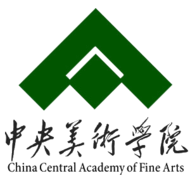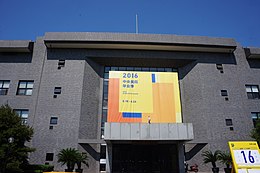Central Academy of Fine Arts
中央美术学院 | |
 | |
Former names | National Beijing Art College[1] |
|---|---|
| Type | Public |
| Established | 1918 |
| President | Fan Di'an (范迪安) |
| Party Secretary | Gao Hong (高洪) |
Academic staff | 572 |
| Students | 4,700 |
| Location | , |
| Campus | Urban, 33 ha (82 acres) |
| Website | www |
| Central Academy of Fine Arts | |||
|---|---|---|---|
| Simplified Chinese | 中央美术学院 | ||
| Traditional Chinese | 中央美術學院 | ||
| |||
The Central Academy of Fine Arts or CAFA is an art academy managed by the Ministry of Education of China. The Manila Bulletin calls the school "China’s most prestigious and renowned art academy".[2] It is considered one of the most selective schools in the country and turns away more than 90% of its applicants each year.[3]
Overview[]
The history of National Art School in Beiping (国立北平艺术专科学校) dates back to the founding of National School of Fine Arts in Beijing in 1918, advocated by the educator Cai Yuanpei. It was the first national school of fine arts in China, and also the beginning of Chinese modern education of fine arts. The academy was founded in April 1950, as a result of merger between National Art School in Beiping and the department of fine arts at third campus of North China University. The former principals of CAFA include Xu Beihong, Jiang Feng, Wu Zuoren, and . Current president is the painter and historian of fine arts, Prof. Pan Gongkai. Current Vice President is renowned contemporary artist, Xu Bing. Current secretary of CPC's committee is Yang Li. Current director of academic commission is the oil painter Jin Shangyi.
The academy comprises six specialty schools: School of Fine Art, School of Chinese Painting, School of Design, School of Architecture, School of Humanities, and School of Urban Design. A post-graduate education school and a high school of fine arts are also affiliated. There are 534 teachers and staffs for 3,800 undergraduate and graduate students, and over 100 international students at school. Its museum of fine arts boasts precious collections, including more than 2,000 Chinese scroll paintings since the Ming dynasty. CAFA edits, publishes and distributes two national first-class academic magazines, "Fine Arts Study" and "Fine Arts of the World".
The design programme of CAFA was renewed in 1995 in the name of the Department of Art Design, after a break of some forty years, and became the School of Design in October, 2002. with the goal of preparing and training the students as future professionals in design with creative thinking and practical capabilities, the School of Design offers undergraduate, graduate and Ph.D. degrees in programs ranging from visual communication design, product design, fashion design, photography, digital media to design theory and history. The School of Design plays an important role in promoting design in China and is intensively involved in design activities, most noticeable of which are its designs for the 2008 Beijing Olympics.
The new CAFA Art Museum, designed by Japanese architect Arata Isozaki, is located at the northeast corner of CAFA campus at No.8, Huajiadi Nan Street, Wangjing, covering an area of 3546 m2, with total floor area of 14 777 m2. The Museum opened in October 2008, for the University's 90th anniversary. The new, six-floor museum has several notable collections, including over 2,000 historic Chinese scroll paintings dating to the Ming Dynasty. The museum hosts rotating exhibitions. Tickets are 10 RMB.
The school drew media attention during the Tiananmen Square protests of 1989, during which the students protested by creating a large statue, called the Goddess of Democracy.[4] Each of the eight art academies signed a statement explaining the purpose of the statue.[5]
In 2018, asteroid 118418 Yangmei was named in honor of the academy.
In 2019, the university was ranked number 27 for art and design in the QS World University Rankings.[6]
Schools and Colleges[]

Faculty of Art and Design[]
- School of Chinese Painting
- School of Fine Art
- Department of Oil Painting
- Department of Printmaking
- Department of Sculpture
- Department of Mural Painting
- School of Experimental Art
- School of Humanities
- Department of Art History and Theory
- Department of Cultural Heritage
- Non-material Cultural Heritage Research Center
- Information Center
- School of Design
- School of Architecture
- College of City Design
- Department of Information Design
- Publishing Design
- Communication Design
- Commercial Information Design
- Department of Product Design
- Ceramic Design
- Artwork Design
- Interior Product Design
- Jewelry Design
- Department of Space Design
- Department of Video Design
- Animation
- Game Design
- Experimental Movie
- Department of Information Design
- School of Arts Administration and Education
Graduate School[]
- Master's Degree Course
- Doctoral Degree Course
Museum of CAFA[]
Set up in the early 1960s, Museum of Central Academy of Fine Arts, formerly CAFA Gallery when it was located at Xiaowei Hutong in downtown Beijing''s Wangfujing Street, always focuses on the collection of artworks and has a rich collection of some 13,000 works which cover a wide variety of genres and styles, including representative works by ancient and modern Chinese masters as well as fine student works since the incorporation of the foundation of the Academy in 1950, across the categories of Chinese painting, oil painting, print, sculpture and folk art such as New Year picture, embroidery and minority ethnic costume and objects, along with Chinese relics of bronze, pottery, engravings and rubbings.[7]
Designed by Arata Isozaki, a renowned Japanese architect, the new museum of CAFA is a building of 14,777 square meters on a land of 3,546 square meters, with four floors above ground and two floors underground. The museum was put into use in September 2008, together with the collection warehouse, permanent and temporary exhibition halls, as well as supporting facilities including artist studios, lecture and conference rooms and cafeteria and bookstore.
Library[]
CAFA‘s Library has a long history. As one of the largest professional libraries in China with the richest collected art books, it has made a collection of 360,000 books and paintings of variety kinds, whose special collection includes wood block New Year pictures, string-bound ancient books with illustrations, rubbings from stone-engraved portraits of Han Dynasty, tablets of various dynasties and the first hand copies from engraved seals, etc., and art books and top quality prints of original artworks published in Europe, America and Japan as well.
The library has set up reading rooms for art books, social science books and magazines and multi-media reading, which are open or half open to readers. Besides that, the library provides CJFD and CDMD of CNKI, e-books on Shushing website, National Palace Museum-Online and Taiwan Doctor/Master Dissertations Database, etc, and its own fine arts reference full-text database and dissertation names in core journals collected by CAFA, etc.
Notable alumni[]
- [8]
- Wu Guanzhong
- Wu Zuoren
- Beohar Rammanohar Sinha
- Zhang Huan
- Fang Lijun[citation needed]
- Hung Liu
- He Chengyao
- Old Xian
- Chen Man
- Xu bing
- Sui Jianguo
- Wu Shaoxiang
- Jiang Shuo
- Yu Xingze
- Yan Cong
See also[]
- Chinese fine art
References[]
- ^ "About CAFA". Official website of Central Academy of Fine Arts. Retrieved 10 June 2015.
- ^ "OIA".
- ^ Barboza, David (2008-03-30). "Central Academy of Fine Arts - China - Art". The New York Times.
- ^ Tsao Tsing-yuan (1994). Jeffrey N. Wasserstrom and Elizabeth J. Perry (ed.). Essay "The Birth of the Goddess of Democracy" from Popular Protest and Political Culture in Modern China. Boulder, Col.: Westview Press. pp. 140–7.
- ^ Minzhu Han (1990). Cries For Democracy: Writings and Speeches from the 1989 Chinese Democracy Movement. Oxford, England: Princeton University Press.
- ^ "China Central Academy of Fine Arts". Top Universities. 2015-07-16. Retrieved 2019-05-18.
- ^ www.cafa.edu.cn, 中国中央美术学院 China Central Academy of Fine Arts (CAFA). "Museum of CAFAAbout-中央美术学院". www.cafa.edu.cn. Retrieved 2018-11-11.
- ^ "Zhang Dali". Archived from the original on 2011-10-22. Retrieved 2011-10-19.
External links[]
| Wikimedia Commons has media related to China Central Academy of Fine Arts. |
- Universities and colleges in Beijing
- Central Academy of Fine Arts
- Educational institutions established in 1950
- 1950 establishments in China
